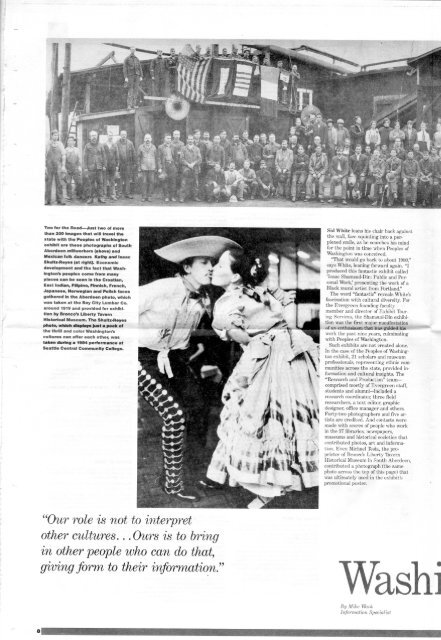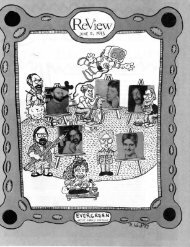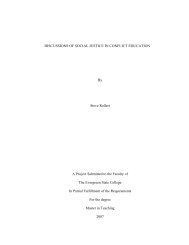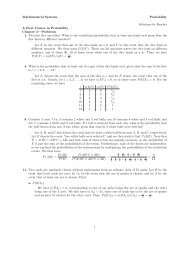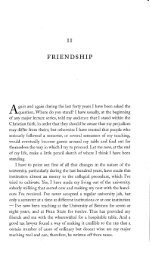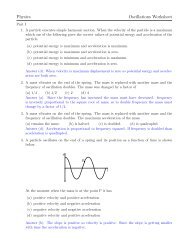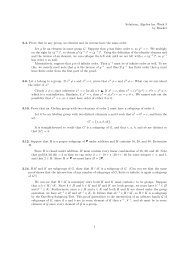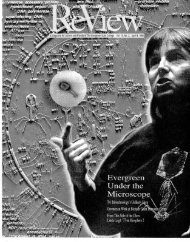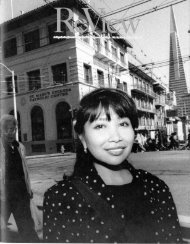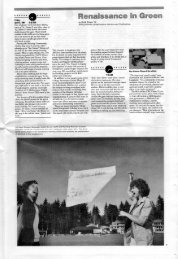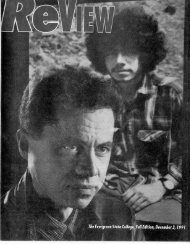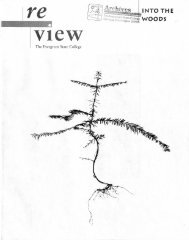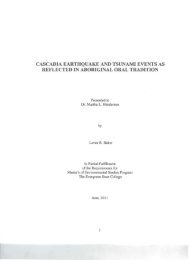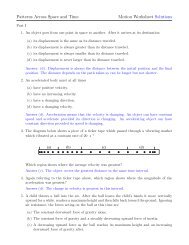V10 #1 November 1988 - Archives - The Evergreen State College
V10 #1 November 1988 - Archives - The Evergreen State College
V10 #1 November 1988 - Archives - The Evergreen State College
You also want an ePaper? Increase the reach of your titles
YUMPU automatically turns print PDFs into web optimized ePapers that Google loves.
B<br />
Two for the Road—Just two of more<br />
than 200 Images that will travel the<br />
state with the Peoples of Washington<br />
exhibit are these photographs of South<br />
Aberdeen millworkers (above) and<br />
Mexican folk dancers Kathy and Isaac<br />
Shultz-Reyes (at right). Economic<br />
development and the fact that Washington's<br />
peoples come from many<br />
places can be seen in the Croatian,<br />
East Indian, Filipino, Finnish, French,<br />
Japanese, Norwegian and Polish faces<br />
gathered in the Aberdeen photo, which<br />
was taken at the Bay City Lumber Co.<br />
around 1919 and provided for exhibition<br />
by Bronco's Liberty Tavern<br />
Historical Museum. <strong>The</strong> Shultz-Reyes<br />
photo, which displays just a peek of<br />
the thrill and color Washington's<br />
cultures can offer each other, was<br />
taken during a 1984 performance at<br />
Seattle Central Community <strong>College</strong>.<br />
"Our role is not to interpret<br />
other cultures.. .Ours is to bring<br />
in other people who can do that,<br />
giving form to their information.<br />
Sid White leans his chair back against<br />
the wall, face squinting into a perplexed<br />
smile, as he searches his mind<br />
for the point in time when Peoples of<br />
Washington was conceived.<br />
"That would go back to about 1980,"<br />
says White, leaning forward again. "I<br />
produced this fantastic exhibit called<br />
'Isaac Shamsud-Din: Public and Personal<br />
Work,' presenting the work of a<br />
Black mural artist from Portland."<br />
<strong>The</strong> word "fantastic" reveals White's<br />
fascination with cultural diversity. For<br />
the <strong>Evergreen</strong> founding faculty<br />
member and director of Exhibit Touring<br />
Services, the Shamsud-Din exhibition<br />
was the first major manifestation<br />
of an enthusiasm that haa guided his<br />
work the past nine years, culminating<br />
with Peoples of Washington.<br />
Such exhibits are not created alone.<br />
In the case of the Peoples of Washington<br />
exhibit, 21 scholars and museum<br />
professionals, representing ethnic communities<br />
across the state, provided information<br />
and cultural insights. <strong>The</strong><br />
"Research and Production" teamcomprised<br />
mostly of <strong>Evergreen</strong> staff,<br />
students and alumni—included a<br />
research coordinator, three field<br />
researchers, a text editor, graphic<br />
designer, office manager and others.<br />
Forty-two photographers and five artists<br />
are credited. And contacts were<br />
made with scores of people who work<br />
in the 37 libraries, newspapers,<br />
museums and historical societies that<br />
contributed photos, art and information.<br />
Even Michael Tesia, the proprietor<br />
of Bronco's Liberty Tavern<br />
Historical Museum in South Aberdeen,<br />
contributed a photograph (the same<br />
photo across the top of this page) that<br />
was ultimately used in the exhibit's<br />
promotional poster.<br />
Washi<br />
By Mike Wark<br />
Information Specialist


